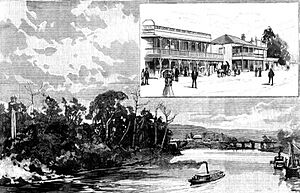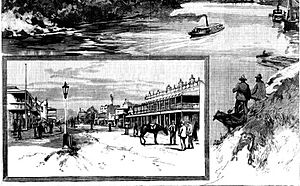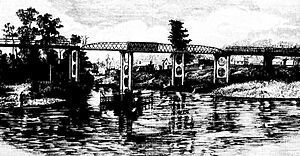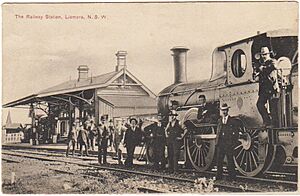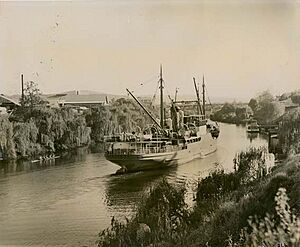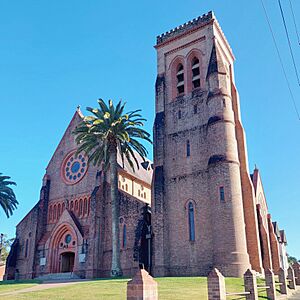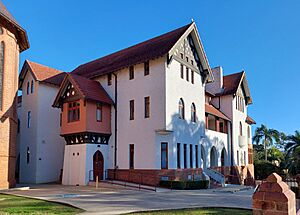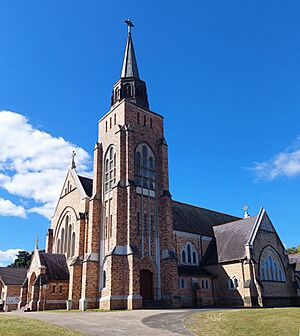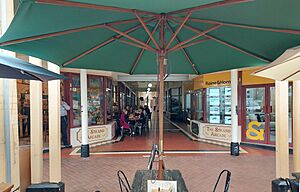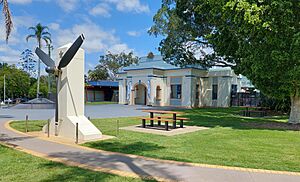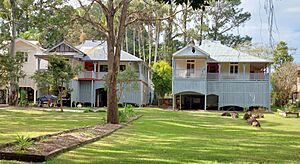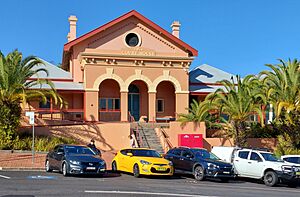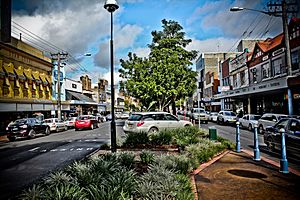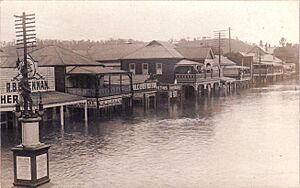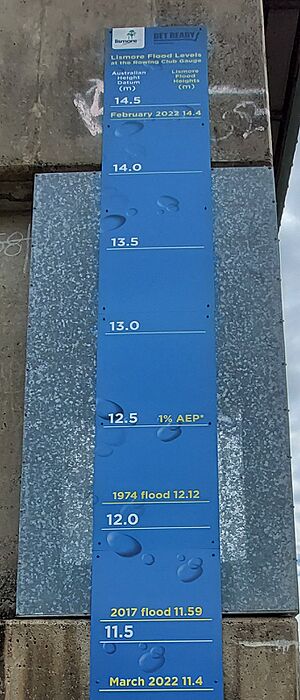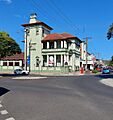Lismore, New South Wales facts for kids
Quick facts for kids LismoreNew South Wales |
|||||||||
|---|---|---|---|---|---|---|---|---|---|
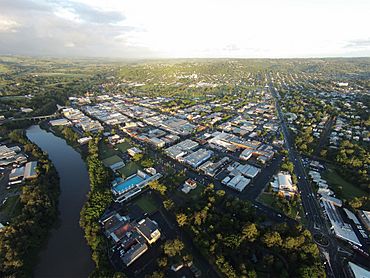
Lismore from helicopter, overlooking the Bruxner Highway and Lismore CBD
|
|||||||||
| Population | 28,816 (2021 census) | ||||||||
| Established | 1856 | ||||||||
| Postcode(s) | 2480 | ||||||||
| Elevation | 12 m (39 ft) | ||||||||
| Location | |||||||||
| LGA(s) | City of Lismore | ||||||||
| County | Rous | ||||||||
| State electorate(s) | Lismore | ||||||||
| Federal Division(s) | Page | ||||||||
|
|||||||||
Lismore is a city in the Northern Rivers region of New South Wales, Australia. It is the main town in the City of Lismore area. Lismore is about 734 km (456 mi) north of Sydney and 200 km (120 mi) south of Brisbane.
The city sits on a low floodplain next to the Wilsons River. This river joins Leycester Creek, and both flow into the Richmond River. The Richmond River then reaches the Pacific Ocean at Ballina, which is about 30 km (19 mi) east.
Lismore started as a grazing area in the 1840s. It then became a town known for timber and farming. It was an important river port, as boats were the main way to travel and move goods back then. As roads and railways grew, river transport stopped around the mid-1900s. Lismore became a city in 1946 and is now the biggest town in the region. It offers many services to the surrounding areas. The city is also on the Bruxner Highway and used to be a stop on the Murwillumbah railway line. It is also home to one of the campuses of Southern Cross University.
Because Lismore is low-lying and near the Wilsons River, it can flood easily when there's a lot of rain. Levees and flood gates help protect it. Big floods happened in 1974, 2017 (after Cyclone Debbie), and the worst ever in 2022. In 2018, money was set aside for more flood protection work. In 2021, Lismore had a population of 28,816 people.
Contents
- A Look Back: Lismore's History
- Lismore's Buildings and Places
- Important Historical Sites
- Lismore's Rainforests
- Lismore's Location
- Weather in Lismore
- Who Lives in Lismore?
- News and Radio in Lismore
- Businesses and Education
- Sports and Fun in Lismore
- Lismore's Sister Cities
- Lismore's Leaders
- Famous People from Lismore
- Images for kids
A Look Back: Lismore's History
First People of Lismore
The land where Lismore now stands belongs to the Bundjalung people. Some suggest the Aboriginal people called this area Tuckurimbah, which means "glutton."
How Lismore Began
British history in Lismore started around 1843. A large sheep farm was set up by Captain Dumaresq. This farm was later taken over by William and Jane Wilson in 1845. The Wilsons were from Scotland. Mrs. Wilson named the farm Lismore, after a small island in Scotland.
In 1855, a surveyor named Frederick Peppercorne chose a spot for a town. This spot was William Wilson's farm. The "Town of Lismore" was officially announced on May 1, 1856. A post office opened in 1859. The Wilson family then built a new home called Monaltrie in 1861, which is one of Lismore's oldest homes.
From the 1840s, timber cutters came to the region. They cut down trees from the huge rainforest called the "Big Scrub." They especially wanted Australian red cedar, known as "red gold." Rivers were the main way to move goods because there were no good roads. Lismore became an important river port. This was because it was the furthest point up the Wilsons River that large boats could reach.
For the next 50 years, Lismore's main industries were cattle farming and timber. This helped the town grow. New businesses like shipbuilding, sawmills, and transport companies started. As the Big Scrub was cleared, the land was used for dairy farms. Many butter factories and dairy groups were set up. Lismore continued to develop with new schools, a wharf, bridges, a railway station, and a post office. By the late 1800s, Lismore had over 4,500 people.
Lismore in the 1900s and Today
At the start of the 1900s, river travel was still key for Lismore. The dairy industry was also very strong. The railway station opened in 1894. It connected Lismore to Byron Bay and Murwillumbah. Later, it also connected to Casino.
However, as the century went on, better roads and cars meant less need for river and train transport. River shipping stopped in the 1950s. The railway line closed in 2004 after 110 years. Despite this, Lismore continued to grow. New buildings and services were added.
Becoming a City
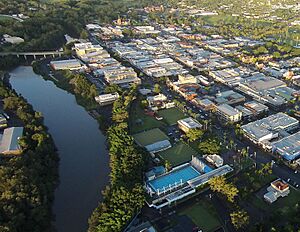
Lismore officially became a city on September 9, 1946. In 1954, Queen Elizabeth II even visited the city. Television came to Lismore in 1956. The local airport got its license in 1969. The 1960s were a time of growth for Lismore. However, the dairy industry began to slow down. Many farmers switched to raising beef cattle.
In 1963, a new bridge (the Ballina St. bridge) opened. It helped carry traffic from the Bruxner Highway across the Wilsons River. Before this, all traffic used the older, narrower Fawcett Bridge.
Later, after the 1973 "alternative society" Aquarius Festival in nearby Nimbin, many people looking for a different lifestyle moved to the area. They bought old dairy farms and brought new ideas. These included building their own homes, living in communities, caring for the environment, and doing artistic things. This led to the area around Lismore being called the "rainbow region."
Lismore also became a center for higher education. The Lismore Teachers College became the Southern Cross University in 1994. Tourism also became important for the region's economy. New farm products like macadamias, avocados, and coffee also grew well here. These crops thrive in the rich soil and warm, wet climate.
As farming and manufacturing changed, more people found jobs in services. In 2016, many people worked in healthcare, retail, education, and food services.
Getting Around Lismore
You can catch regular bus services from Lismore to places like Byron Bay, Ballina, and Nimbin. These bus tickets can only be bought with cash on the bus. Some residents feel the transport system needs improvements, especially outside the city center.
Lismore's Buildings and Places
Lismore has many old and interesting buildings. These include the old Council Chambers (built 1928), which is now a museum. The museum has old items, documents, and photos about the area's history. Other notable buildings are the beautiful post office (1897), the old Australian Joint Stock Bank (1891), and the courthouse (1883).
The Lismore Memorial Baths (1928) were built to remember local people who died in World War I. There are also several historic churches, such as St. Andrew's Anglican Church (1904) and St. Carthage's Roman Catholic Cathedral (1892–1907).
The city center has many old shopfronts from the late 1800s to mid-1900s. A cool feature is the many arcades, like the Star Court Arcade from the 1920s. These arcades let shoppers stay dry during heavy rain or comfortable in hot or cold weather.
Many homes in Lismore are "high set." This means the living areas are on the first floor, with open space underneath. This design helps keep houses cool in summer. These spaces are often now used as garages or extra rooms. Most houses also have covered verandahs. These provide shade from the sun and a dry outdoor area during wet weather.
Lismore has many parks and gardens, some along the river. Rotary Park is a small regenerated rainforest near the city center. The Wilson Nature Reserve is a 27-hectare piece of the original "Big Scrub" rainforest.
Important Historical Sites
Lismore has several sites listed on the New South Wales State Heritage Register. These are important places that are protected because of their history. They include:
- Colemans Bridge over Leycester Creek
- Lismore railway station group
- Lismore railway underbridges
The local council also lists about 42 other important sites. These include the 1883 Court House, the Commonwealth Bank building, and the Memorial Baths. You can find a full list of heritage sites by searching the New South Wales Heritage Database.
Lismore's Rainforests
Lismore and nearby towns were once covered by a huge rainforest called the "Big Scrub." After British settlement, less than one percent of this rainforest remains. You can still see parts of this rainforest at Southern Cross University and at Wilsons Nature Reserve.
Lismore's Location
Lismore is located on the Bruxner Highway. It sits where the Wilsons River and Leycester Creek meet. The state capital city of Sydney is about 764 km (475 mi) south by road. Brisbane, the capital of Queensland, is 200 kilometres (124 mi) north.
Lismore's city center is about 35 kilometres (22 mi) from the coast. It is 46 kilometres (29 mi) southwest of Byron Bay. The coastal town of Ballina is 36 kilometres (22 mi) away. There are small patches of rainforest left in the area, like Boatharbour Reserve. The closest large national park is Nightcap National Park.
Weather in Lismore
General Weather Patterns
Lismore has a humid subtropical climate. This means it has mild to warm temperatures all year and plenty of rain. The average yearly rainfall is 1,343 mm. Summer temperatures are usually between 20 °C (68 °F) and 35 °C (95 °F). The climate and location make Lismore very humid in summer, sometimes reaching 100% humidity. Lismore has about 110 clear days each year.
Flooding in Lismore
Lismore is known for frequent floods from the Wilsons River and Leycester Creek. The worst flood on record was in 2022, when the water reached an amazing 14.4 metres (47 ft). Before that, big floods happened in 1954 and 1974, reaching 12.1 metres (40 ft). The Lismore council has published a history of floods from 1870 to 2022.
In 1999, a plan was approved to protect the city center and South Lismore from smaller floods. This plan included building a levee wall. In 2005, about 3,000 Lismore residents had to leave their homes due to floods. However, the new levee helped protect the city center.
In March 2017, after Cyclone Debbie, Lismore flooded badly again. The Wilsons River reached 11.6 metres (38 ft), and the levee was topped for the first time. In 2018, more money was announced for flood protection.
In February 2022, Lismore had its biggest flood ever. The Wilsons River reached 14.37 meters. This caused huge damage to many buildings and homes. Rebuilding is still ongoing a year later.
Drought and Water Supply
The Northern Rivers region can have very different amounts of rain each year. Less rain often happens during El Niño events, and more rain during La Niña events. Lismore can experience droughts, but it's generally less prone to them than other areas.
Lismore gets its water from Rocky Creek Dam. This dam is in a rainy area about 20 km north of the city. Water can also be taken from the Wilsons River if needed. If the dam level drops too low, water restrictions are put in place. From 2002 to 2019, there was only one period of severe water restrictions.
Other Weather Events
Lismore often gets strong storms in spring and summer. For example, a severe hailstorm hit in October 2007. While very rare, a tornado even struck nearby Dunoon later that month.
Experts have studied natural risks in different areas of Australia. For Lismore, the risk of floods is rated as high. The risk for storms and bushfires is medium, and for earthquakes and tropical cyclones, it is low.
| Climate data for Lismore | |||||||||||||
|---|---|---|---|---|---|---|---|---|---|---|---|---|---|
| Month | Jan | Feb | Mar | Apr | May | Jun | Jul | Aug | Sep | Oct | Nov | Dec | Year |
| Record high °C (°F) | 43.4 (110.1) |
42.8 (109.0) |
37.2 (99.0) |
35.6 (96.1) |
30.6 (87.1) |
28.1 (82.6) |
28.9 (84.0) |
32.7 (90.9) |
37.2 (99.0) |
39.8 (103.6) |
42.2 (108.0) |
40.6 (105.1) |
43.4 (110.1) |
| Mean daily maximum °C (°F) | 29.9 (85.8) |
29.1 (84.4) |
27.9 (82.2) |
25.7 (78.3) |
22.6 (72.7) |
20.2 (68.4) |
19.9 (67.8) |
21.5 (70.7) |
24.4 (75.9) |
26.6 (79.9) |
28.2 (82.8) |
29.7 (85.5) |
25.5 (77.9) |
| Mean daily minimum °C (°F) | 18.8 (65.8) |
18.8 (65.8) |
17.4 (63.3) |
14.2 (57.6) |
10.9 (51.6) |
8.5 (47.3) |
6.5 (43.7) |
7.2 (45.0) |
9.9 (49.8) |
13.2 (55.8) |
15.8 (60.4) |
17.8 (64.0) |
13.2 (55.8) |
| Record low °C (°F) | 11.6 (52.9) |
11.8 (53.2) |
10.0 (50.0) |
5.0 (41.0) |
1.1 (34.0) |
−1.0 (30.2) |
−3.5 (25.7) |
−2.0 (28.4) |
−0.3 (31.5) |
2.8 (37.0) |
6.1 (43.0) |
7.8 (46.0) |
−3.5 (25.7) |
| Average rainfall mm (inches) | 155.4 (6.12) |
183.6 (7.23) |
188.4 (7.42) |
129.2 (5.09) |
115.3 (4.54) |
97.0 (3.82) |
80.3 (3.16) |
54.9 (2.16) |
50.4 (1.98) |
73.2 (2.88) |
94.1 (3.70) |
121.3 (4.78) |
1,343.1 (52.88) |
| Average rainy days (≥ 0.2mm) | 12.9 | 13.9 | 15.6 | 12.5 | 11.6 | 9.5 | 8.3 | 7.5 | 7.4 | 9.0 | 10.0 | 11.4 | 129.6 |
| Average afternoon relative humidity (%) | 58 | 61 | 60 | 58 | 59 | 56 | 51 | 46 | 45 | 50 | 51 | 55 | 54 |
| Source 1: Bureau of Meteorology | |||||||||||||
| Source 2: For February record high: Weatherzone | |||||||||||||
Who Lives in Lismore?
In 2021, Lismore had 28,816 people.
- About 7.1% of people were Aboriginal and Torres Strait Islander people.
- Most people (83.5%) were born in Australia. Others came from England (2.1%), New Zealand (1.1%), and the Philippines (0.6%).
- English was the only language spoken at home by 87.7% of people.
- The most common religions were No Religion (41.8%), Catholic (19.4%), and Anglican (11.8%).
Lismore's population was highest in 2012 with 29,320 people. It has slowly gone down to 28,816 in 2021. The central part of Lismore had 3,656 people in 2021.
| Historical population | ||
|---|---|---|
| Year | Pop. | ±% |
| 1921 | 8,700 | — |
| 1933 | 11,762 | +35.2% |
| 1947 | 15,214 | +29.3% |
| 1954 | 17,372 | +14.2% |
| 1961 | 18,935 | +9.0% |
| 1966 | 19,757 | +4.3% |
| 1971 | 20,904 | +5.8% |
| 1976 | 22,082 | +5.6% |
| 1981 | 24,033 | +8.8% |
| 1986 | 24,896 | +3.6% |
| 1991 | 27,246 | +9.4% |
| 1996 | 28,380 | +4.2% |
| 2001 | 27,193 | −4.2% |
| 2006 | 27,069 | −0.5% |
| 2011 | 27,474 | +1.5% |
| 2016 | 27,569 | +0.3% |
| 2021 | 27,916 | +1.3% |
| Source: Australian Bureau of Statistics data. | ||
News and Radio in Lismore
The Northern Star is an online newspaper based in Lismore. It covers news for Lismore and nearby towns. It used to be a printed newspaper but became online-only in 2020.
The Northern Rivers Echo was a free weekly newspaper for the area. The Lismore CBD Magazine is a monthly online magazine.
Lismore has several radio stations:
- Triple Z (100.9 FM) plays hit music.
- 2LM (900 AM and 104.3 FM) also plays music.
- River FM 92.9 is a community radio station with different types of music.
- ABC North Coast (94.5 FM) is a public radio station.
All major TV channels are available in Lismore and the Northern Rivers region.
Businesses and Education
The Norco Co-operative, a dairy farmers' group, has its main office in Lismore. The main campus of Southern Cross University is also in Lismore.
Learning in Lismore
Southern Cross University has its main campus in Lismore. It offers many courses for students. These include business, law, tourism, arts, education, science, and health. The university started in 1994 and has students from over 80 countries.
Lismore and the surrounding area have many public and private schools, including:
- Albert Park Public School
- Blue Hills College
- Kadina High Campus
- Lismore High Campus
- Lismore Public School
- Lismore South Public School
- Living School Lismore
- Our Lady Help of Christians Catholic Primary School
- Richmond River High Campus
- St Carthage's Catholic Primary School
- St John's College, Woodlawn
- Summerland Christian College
- Trinity Catholic College, Lismore
- Vistara Primary School
Sports and Fun in Lismore
Lismore has two rugby league clubs that play in the Northern Rivers Regional Rugby League competition:
The Lismore Marist Brothers Rams won the famous Clayton Cup in 1987. This means they were the best local rugby league team in Country New South Wales that year.
Lismore is also big on association football (soccer). Six clubs from the Football Far North Coast are based in Lismore:
- South Lismore Celtic (started 1946)
- Lismore Workers (started 1949)
- Lismore Thistles (started 1958)
- Richmond Rovers (started 1961)
- Italo Stars (started 1966, no longer active in 2023)
- Goonellabah (started 1969)
The Albert Park complex is home to the Far North Coast Baseball Association. Lismore is known as one of the strongest places for Baseball in Australia.
The Lismore Swans started in 1983 and play Australian rules football in the AFL North Coast competition.
Lismore Speedway is a race track at the Lismore Showgrounds. It often hosts big national and state racing events.
Lismore's Sister Cities
Lismore has special "sister city" relationships with other cities around the world. These relationships help people from different places learn about each other's cultures.
- Yamatotakada, Japan (since 1963). This was the first sister city link between Australia and Japan.
- Eau Claire, Wisconsin, USA
- Lismore, County Waterford, Ireland
Lismore's Leaders
- The Member of NSW State Parliament for Lismore is Janelle Saffin MP (from the Labor party).
- The Mayor of the City of Lismore is Steve Krieg (an Independent).
- The Deputy Mayor of the City of Lismore is Jeri Hall (an Independent).
Famous People from Lismore
Many well-known people have come from or lived in Lismore, including:
- Julian Assange – founder of WikiLeaks.
- Andrew Barr – the Chief Minister of the Australian Capital Territory.
- Lisa Casagrande – a footballer who played for the Matildas.
- Con Colleano – a famous tightrope walker.
- Bob Ellis – a writer and journalist.
- Craig Foster – a former Socceroo and human rights advocate.
- Adam Gilchrist – a famous cricketer.
- Grinspoon – a popular rock band.
- Nicholas Hamilton – an actor known for his role in the movie It.
- Maia Mitchell – an actress known for her roles in The Fosters and Good Trouble.
- Margaret Olley AC – a famous Australian artist.
- James Strong AO – a former CEO of Qantas.
Images for kids



